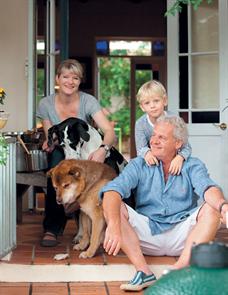As welcoming as she is successful, renowned Franschhoek chef Margot Janse loves nothing better than to surround herself with friends and family on her days off.
“Come in, come in,” says Margot Janse, ushering me out of the unseasonal summer rain and into her Franschhoek country home. At the entrance is her kitchen where fellow chef, Vanie Padayachee, is shucking oysters. A pan sizzles behind her, a rhythmic accompaniment to the shower outside. The living area spills out onto the porch and the wild, lush garden beyond. Thomas, Margot’s eight-yearold son, tears through the living room with a playmate in tow. His dad, Duncan Doherty, also a chef (at Vrede en Lust’s Cotage Fromage), calls after them to help with the egg yolk raviolis. The boys dutifully oblige and soon little hands are churning out flat sheets of pasta on the outside table.
Dutch-born Margot has carved a celebrated culinary career in South Africa that spans two decades. She collects awards – both local and international – as if she were picking cherries to fill a basket. Her restaurant, The Tasting Room at Le Quartier Français, has been in the San Pellegrino Top 50 Restaurants in the World for eight years. The Franschhoek restaurant also recently claimed the number two spot in the annual Eat Out Top 10 – it has made it onto the list an unprecedented 11 times. Plus, Margot was crowned Eat Out’s Chef of the Year. There’s more, but I won’t bore you. What Margot also is, is a mother, wife and friend to many. Oh, and she’s hilarious.
Not that she isn’t intimidating; she is. Sharp as nails, with an iron focus, Margot’s a commanding presence in the restaurant kitchen. One of only two Relais & Châteaux Grand Chefs in the country, her food is a beacon of contemporary, innovative South African cuisine. Timeless African ingredients, like baobab and buchu, are reinvented to tell a story on restaurant plates. The food is at once ancient and new, clever yet whimsical. The juxtaposition of imaginative cooking techniques rooted in nostalgia is what makes dining at The Tasting Room utter food theatre. The long, wooden table on the porch has been wiped clean of flour spills and egg shells. We settle there with flutes of champagne and tuck into West Coast oysters with suurvygies (sour figs) – fruit of a native South African succulent.
“The suurvgyies were picked at the dam in front of our house,” says Margot, pointing in the general direction. “Suurvygies have a unique flavour. The acidity works beautifully with the sweetness of the oysters.” Another glass of bubbles is poured. It’s Margot and Duncan’s favourite drink. A garland of corks stretching across the entire porch is testament to this love, as well as to theirs – they’ve been collecting them since the day they met, 16 years ago. Plates of egg yolk ravioli with sautéed porcinis whizz out of the kitchen with restaurant precision. “When you slice the ravioli open, the yolk becomes the sauce,” explains Margot.
“The most important thing with this dish is to use biodynamic eggs,” adds Duncan. We use Farmer Angus’s.” Indeed, the yolk is so rich and golden, it’s sunshine on the plate. Farmer Angus is Margot’s most treasured supplier. His beef short ribs are also on today’s menu; they’ve been slowly cooking in the Big Green Egg outside in the garden. Margot opens the ceramic cooking appliance to baste the ribs (each the size of a ciabatta loaf). Soon the ribs are ready and sliced for our plates. “I can’t deal with ribs where there’s no meat,” says Margot, tucking into a sticky short rib that measures three fingers high. This is served with an assortment of heirloom vegetables, “…vegetables we’ve either forgotten or not discovered yet”.
Accompanying the ribs is a pickled cucumber salad, a traditional side on Dutch tables. “I’ve added thinly sliced runner beans. My mother had an allotment, and when the runner beans came in, she ran them through a special mill she kept at home. So I mixed the beans with her cucumber pickle.” This anecdote illustrates the way Margot approaches cooking; she draws on nostalgia. That, and food always seems to taste better with a story. Thomas has left the adults to their conversation, and Duncan regales the table with a story about him as a four-year-old eating four oysters at a restaurant, while he himself could only stomach two. During the tale we demolish Duncan’s sticky tarte Tatin, made with juicy Elgin pears. “Before I met Duncan that used to be the tart in his life,” says Margot winking. I told you she was funny.
By MALU LAMBERT
SOURCES
Photographs by BRUCE TUCK

